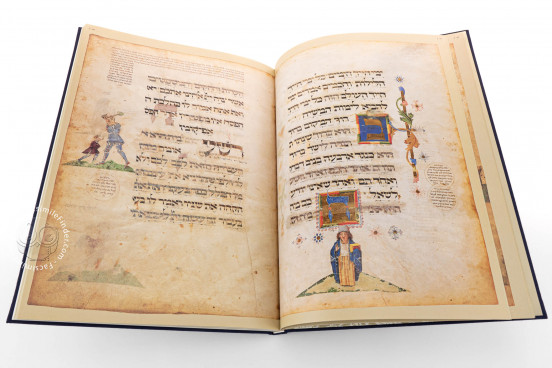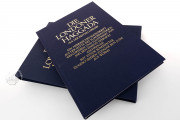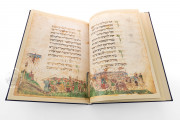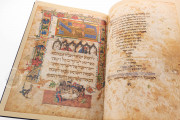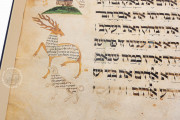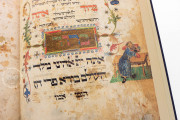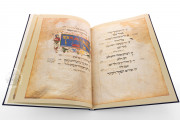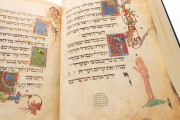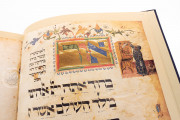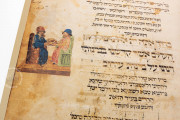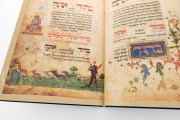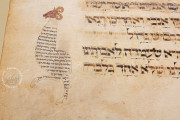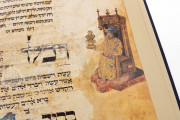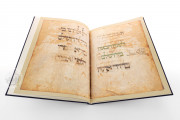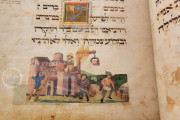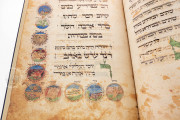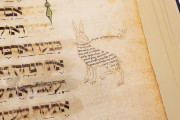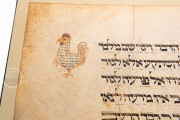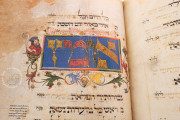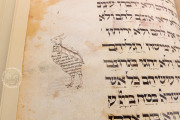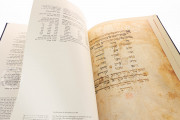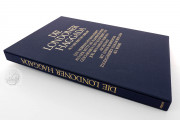The Ashkenazi Haggadah is a large, illustrated manuscript for the seder, the ceremonial dinner held on the first evening—or first and second evenings—of the Jewish feast of Passover. Created in southern Germany, probably in Ulm, around 1460 and illuminated by Joel ben Simeon, it features painted headpieces, pen-flourished letters, and tooled gilding, as well as stocky, whimsical figures that inhabit the margins.
The program of illumination includes depictions of some of the Passover rituals and roundels of the ten plagues visited upon the Egyptians as recounted in the Hebrew Bible (fol. 17r).
For the Celebration of Passover
The Haggadah—the "telling" or "story"—recounts the ancient Israelites' exodus from Egypt compiled from biblical and rabbinic sources. It includes the texts of many blessings and the descriptions of actions undertaken during the seder.
The rather large pages of the London manuscript are arranged in a single column written in a formal Hebrew Square Script by Meier Jaffe. The Haggadah text is accompanied by excerpts of a commentary by Eleazar ben Judah of Worms (1176-1238) written in smaller, less formal script in the margins.
A Highly Decorated Text
In the London Ashkenazi Haggadah, major divisions of the text are demarcated by elaborate headpieces (word panels) where both the ground and contrasting letters are filled with stylized leaves. In many instances, foliate motifs and human figures surround the panels. The commentary text found in the margins is often presented as figured writing, with the text forming animals and fantastic beasts.
The Hunting of the Hare
Most of the vignettes in the margins of the Ashkenazi Haggadah illustrate actions to be undertaken in association with the seder or phrases of the text; the meal itself with Haggadot in use is pictured in one scene (fol. 6r).
One charming bas-de-page scene—perhaps an invention of Joel ben Simeon—illustrates a mnemonic Hebrew acronym formed of the first letters of the order of blessings: YaKNeHaZ, which when said aloud sounds like the German for "Hunt the hare." (fol. 4r). Pictured on a strip of landscape is a hunter with horn and four hounds chasing a pair of hares.
The Crossing of the Red Sea
The London manuscript is famous for its elaborate depiction of the climax of the "telling": the crossing of the Red Sea, which extends across the bottom of two facing pages (fols. 14v-15r). The Israelites, led by a pillar of fire, are about to enter the sea, populated by fish.
Moses, rod in hand, looks up to the Hand of God, which emerges from a cloud above him. That cloud rains fire and sulfur on the Egyptian city below. The Egyptian army, including Pharoah, is separated from the Israelites by a cloud pillar, reflecting the rabbinic commentary on the biblical story.
A Known Patron
As is frequently the case for late medieval Haggadot, the patron of the London manuscript is known. The book was originally painted for Jacob Mattathiah, as reported in the illuminator's colophon (fol. 48v). At some point after ben Simeon finished his work, another artist, perhaps Johann Bämler, repainted some of the vignettes. The book's history is unknown until it was purchased by the British Museum in the nineteenth century.
The manuscripts of the British Museum library were transferred to the British Library when it was established in 1973. The Haggadah's binding of tooled brown leather is early, perhaps contemporary with the book's creation.
We have 1 facsimile edition of the manuscript "Ashkenazi Haggadah": Die Londoner Haggada facsimile edition, published by Herder, 1985
Request Info / Price
